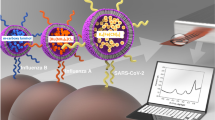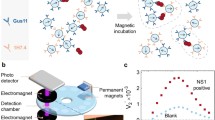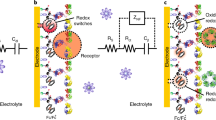Abstract
A multi-analyte biosensor based on nucleic acid hybridization and liposome signal amplification was developed for the rapid serotype-specific detection of Dengue virus. After RNA amplification, detection of Dengue virus specific serotypes can be accomplished using a single analysis within 25 min. The multi-analyte biosensor is based on single-analyte assays (see Baeumner et al (2002) Anal Chem 74:1442–1448) developed earlier in which four analyses were required for specific serotype identification of Dengue virus samples. The multi-analyte biosensor employs generic and serotype-specific DNA probes, which hybridize with Dengue RNA that is amplified by the isothermal nucleic acid sequence based amplification (NASBA) reaction. The generic probe (reporter probe) is coupled to dye-entrapping liposomes and can hybridize to all four Dengue serotypes, while the serotype-specific probes (capture probes) are immobilized through biotin–streptavidin interaction on the surface of a polyethersulfone membrane strip in separate locations. A mixture of amplified Dengue virus RNA sequences and liposomes is applied to the membrane and allowed to migrate up along the test strip. After the liposome-target sequence complexes hybridize to the specific probes immobilized in the capture zones of the membrane strip, the Dengue serotype present in the sample can be determined. The amount of liposomes immobilized in the various capture zones directly correlates to the amount of viral RNA in the sample and can be quantified by a portable reflectometer. The specific arrangement of the capture zones and the use of unlabeled oligonucleotides (cold probes) enabled us to dramatically reduce the cross-reactivity of Dengue virus serotypes. Therefore, a single biosensor can be used to detect the exact Dengue serotype present in the sample. In addition, the biosensor can simultaneously detect two serotypes and so it is useful for the identification of possible concurrent infections found in clinical samples. The various biosensor components have been optimized with respect to specificity and sensitivity, and the system has been ultimately tested using blind coded samples. The biosensor demonstrated 92% reliability in Dengue serotype determination. Following isothermal amplification of the target sequences, the biosensor had a detection limit of 50 RNA molecules for serotype 2, 500 RNA molecules for serotypes 3 and 4, and 50,000 molecules for serotype 1. The multi-analyte biosensor is portable, inexpensive, and very easy to use and represents an alternative to current detection methods coupled with nucleic acid amplification reactions such as electrochemiluminescence, or those based on more expensive and time consuming methods such as ELISA or tissue culture.







Similar content being viewed by others
References
Mongkolsapaya J, Dejnirattisai W, Xu X, Vasanawathana S, Tangthawornchaikul N, Chairunsri A, Sawasdivorn S, Duangchinda T, Dong T, Rowland-Jones S, Yenchitsomanus P, McMichael A, Malasit P, Screaton G (2003) Nat Med 9:921–927
Gubler D (1997) In: Gubler DJ, Kuno G (eds) Dengue and dengue hemorrhagic fever. CAB International, Cambridge, pp 1–22
World Health Organization (2000) Strengthening the implementation of the global strategy for dengue fever/dengue hemorrhagic fever prevention and control. WHO, Geneva
Chakravarti A, Gur R, Berry N, Mathur M (2000) Diagn Microbiol Infect Dis 36:273–274
Balmaseda A, Guzman M, Hammond S, Robleto G, Flores C, Tellez Y, Videa E, Saborio S, Perez L, Sandoval E, Rodriguez Y, Harris E (2003) Clin Diag Lab Immunol 10:317–322
Henchal E, Putnak J (1990) Clin Microbiol Rev 3:376–396
Lanciotti R, Calisher C, Gubler D, Chang G, Vorndam A (1992) J Clin Microbiol 30:545–551
Laue T, Emmerich P, Schmitz H (1999) J Clin Microbiol 37:2543–2547
Wu S, Lee E, Putvatana R, Shurtliff R, Porter K, Suharyono W, Watt D, King C, Murphy G, Hayes C, Romano J (2001) J Clin Microbiol 39:2794–2798
Esch M, Baeumner A, Durst R (2001) Anal Chem 73:3162–3167
Baeumner A, Cohen R, Miksic V, Min J (2003) Biosens Bioelectron 18:405–413
Baeumner A, Hartley H (2003) Anal Bioanal Chem 376:319–327
Baeumner A, Pretz J, Fang S (2004) Anal Chem 76:888–894
Baeumner A, Jones C, Wong C (2004) Anal Bioanal Chem 378:1587–1593
Baeumner A, Schlesinger N, Slutzki N, Romano J, Lee E, Montagna R (2002) Anal Chem 74:1442–1448
Compton J (1991) Nature 360:91–92
Siebert S, Reeves S, Durst R (1993) Anal Chim Acta 282:297–305
Eckels K, Brandt W, Harrison V, McCown J, Russel P (1976) Infect Immunol 14:1221–1227
Boom R, Sol C, Salimans M, Jansen C, Wertheim-van Dillen P, van der Norda J (1990) J Clin Microbiol 20:495–503
Romano J, Shurtliff R, Dobratz E, Gibson A, Hickman K, Markham P, Pal R (2000) J Virol Methods 86:61–70
CDC (1998) Morbidity and mortality weekly report (MMWR). Centers for Disease Control and Prevention, Atlanta, GA, pp 952–956
Wang W, Chao D, Lin S, King C, Chang S (2003) J Microbiol Immunol Infect 36:89–95
Rocco I, Barbosa M, Kanomata E (1998) Rev Inst Med Trop Sao Paulo 40:151–154
Acknowledgements
The authors acknowledge financial support for this project from Innovative Biotechnologies International, Inc., from the National Institute of Allergy and Infectious Diseases (NIAID), Bethesda, MD, USA, from the New York State CAT, Biotechnology Program at Cornell University, and from the Cooperative State Research, Education and Extension Services (NYC-123314). We thank M.G. Sarngadharan and Roxanne N. Shurtliff from Advanced BioScience Laboratories, Inc., for their many discussions and help in moving the project along. We also want to thank Sutee Yoksan from Mahidol University, Thailand and Shuenn-Jue Wu from Naval Medical Research Center, USA, for providing us with Dengue virus samples that were used in this publication.
Author information
Authors and Affiliations
Corresponding author
Rights and permissions
About this article
Cite this article
Zaytseva, N.V., Montagna, R.A., Lee, E.M. et al. Multi-analyte single-membrane biosensor for the serotype-specific detection of Dengue virus. Anal Bioanal Chem 380, 46–53 (2004). https://doi.org/10.1007/s00216-004-2724-9
Received:
Revised:
Accepted:
Published:
Issue Date:
DOI: https://doi.org/10.1007/s00216-004-2724-9




